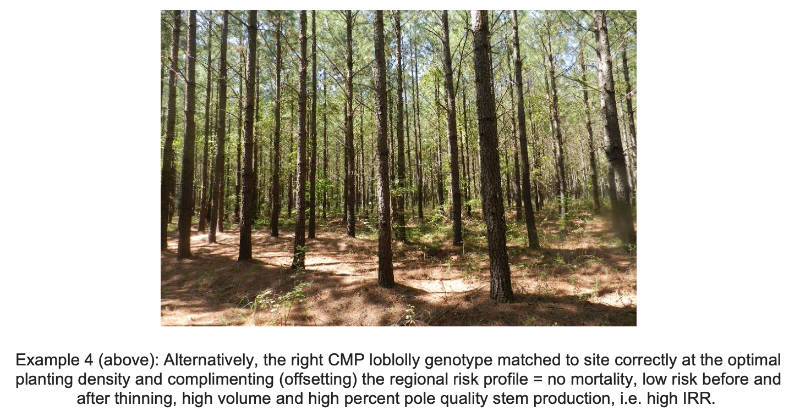Every forest investment has a potential return and a host of inherent risks. Inherent risks include market uncertainties, undesirable environmental events and inefficient management decisions; all leading to less returns than expected due to lower volume or quality of timber production or reduced cash flow due to pricing. Having an asset management strategy that results in both high timber production and protection against risk is important. A strong strategy to offset known and emerging forest risks should be part of any forest investment plan. New, emerging understandings of genetic, density, site and regime interactions are increasing our operational abilities to manage risk at the stand and forest levels. This is great news in a changing biological environment and a changing economic environment. Let’s consider how a few of these emerging understandings can affect risk management in our pine plantation investments.
At a high level, traditional forest-scale risk management methods include:
- Utilization of geographic diversification for mediation of exposure to market and environmental risks
- Diversification of age-structure for mediation of environmental risks, and
- Diversification of target timber products to lower economic market risks over time.
At the stand-level, historical risk management strategies include:
- Proper species assignment to soil type and market.
- Active planting of higher densities of bare-root seedlings, and/or using container seedlings to proactively offset mortality losses and provide more selection at the time of thinning when removing stem quality degrades
- Installation of fire-lines around at-risk stands
- Management of timber stand density to maintain vigorous live crowns
- Management of nutrition levels to keep tree and stand vigor high
These options, both at the forest-level and stand-level are still important to consider and implement. But, empowered by the genetic revolution of the early 2000’s, a timber portfolio manager’s options for managing market, environmental, and management risk is greatly increased today. The genetic revolution (not just the existence of improved genotypes and level of tree improvement, but equally important, the insight of how to use them) has resulted in:
- Increased availability of new genotype seedlings (Open Pollinated Elite, CMP- Controlled Mass Pollinated, and Varietal Populations) that have greater growth potential and less inherent stem degrades.
- Fuller characterization (beyond conventional tree improvement measures) of each genotypes stem traits that affect stem quality and risk,
- An understanding of crown and stem characteristics that can be used to minimize damage from known regional risks
- A better understanding of each genotypes stem quality stability when grown on high resource sites or in intensively managed regimes.
- An understanding of how the characterized stem and crown traits can enable silviculture regimes that produce higher return potential with lower risk.
- An understanding of which genotypes to allocate to which sites to maximize stand quality and minimize stand risk
At the forest-level, genetic choice risk reduction considerations include:
- Purposely utilizing genotypes that have increased adaptability for known risk factors. More adaptable genotypes are being produced through focused CMP breeding and through full utilization of all loblolly pine gene pools (utilizing both Provenance and individual pedigree gene-stacking);
- Purposeful deployment of a mix of OP, CMP, and Varietal seedlings to offset known risks (must have understanding of what risk management benefits each level of tree improvement brings, and any limitations).
- Assignment of varied genotypes and deployment regimes to ensure that production and stem quality are optimized on each soil type and for each market zone.
At the stand level, new risk management tools include:
- Assigning initial planting density based on genetic control of branch size development and the soil resources present
- Planting stable genotypes on high resource sites
- Full use of improved crown and stem ideotypes to reduce risk to weather elements
- Use of CMP-infused seed mixes to increase genetic diversity and adaptability
p>Collectively, full use of both the historical and new risk-management tools is increasingly important as our natural tree growing environments seem to be becoming increasingly risky with increasing temperatures (creating an increased ‘power’ gradient), subsequent increased winds, sporadic precipitation trends, and warm weather winter interruptions.
These advanced understandings for managing risk at the forest and stand level are both exciting and important to apply for all forest investors. While room for discussion is limited here, there will be substantial opportunities for increasing your understanding of risk management options at the upcoming Forest Owners Research and Technology Exchange Participant’s Meeting in Columbus GA on October 22-23, 2019. If managing risk is important to you or your clients, view the meeting agenda by clicking on the link: FORTE Fall 2019 Exchange Meeting.
Come and be a part of the discussion and information exchange in Columbus, GA this October!




